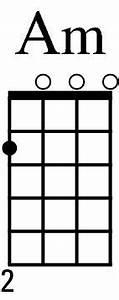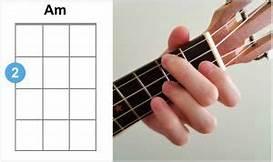Looking to play an A Minor Chord on the ukulele? You’re in the right place. First, let’s take a look at the difference between a single note and a chord before progressing to minor chords on ukulele.
A note is a single tone, whereas a chord is characterized as 3 or more notes played simultaneously. Singular notes are commonly used in writing melodies, improvisation, or soloing.
Chords are used for harmonization and creating chord progressions.
So, Just How Do You Play the Ukulele Chord A Minor?
Let’s talk about creating an A Minor chord on a ukulele. This requires the playing of three specific notes on your ukulele.
The notes are: A – C – E .
To begin, you need to know the notes of an “open stringed” ukulele. “Open stringed” means when you are not placing your fingers on the strings. So, string numbers go as follows: 4 – 3 – 2 – 1.
The 4th string is the one closest to your chin. That string note is G. 3rd string is C. 2nd string is E. 1st string, furthest from your chin, is A.
Finger Placement for an A Minor Chord
Your first finger is your pointer finger, second finger is your middle finger, third finger is your ring finger, and fourth finger is your pinky.
Now, an unwritten rule I like to follow is using your first finger in the first fret, second finger in the second fret, third finger in the third fret and fourth finger in the fourth fret. Doing this helps with chord transitioning, and allows you to develop stronger fingers.
To make an A Minor ukulele chord, place your second finger on the fourth string, the string closest to your chin, in the second fret. While strumming all four strings you are playing the notes A – C – E.
These are the notes of an A Minor chord. Here is a chart below. The O represents open strings. Now, you might ask, an A Minor chord has only 3 notes in it and I am playing four strings. Well the notes you are playing, from fourth to first string are: A – C – E – A. There is a doubling of the note A. That is perfectly acceptable seeing that the note A is still part of the chord. Doubling of the same note helps make a fuller sound to the chord.
Proper Finger Shape When Playing Uke
It is always good to place your finger tips, not your fingerprints, on the strings. Like I tell my young students, “ think of eagle’s claws”. The majority of uke minor chords played require your finger knuckles to be popped up. This helps avoid “dead notes”. Those are notes that are not cleanly heard.
In addition, take a look at the frets of your ukulele. Those are the spaces on the ukulele neck that are individually separated. Now, when you place your A Minor chord, place your fingers at the back end of the frets. The back end of the fret is situated towards the body of the ukulele where you strum.
Be Patient & Practice… Again & Again!
Learning to play minor chords uke and chord transitioning is key to learning to play and create popular songs. Like any other objective, taking your time and having patience is key to acquiring this skill. Take it slow and shoot for perfection, instead of trying to rush and become frustrated about not resolving issues you might have.
One of the most common issues when students start to form chords is the placement of your fingers simultaneously in the chord positions. Learning chord transitioning, your finger movement should be smooth and calculated. The best exercise in that is transitioning between two chords, back and forth. Once you are comfortable in that transitioning you can add other minor chords on ukulele
Damien Simon


